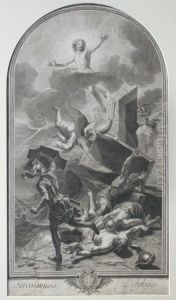Jean Audran Paintings
Jean Audran was born in 1667 in Lyon, France, into a family with a strong artistic tradition. His father, Germain Audran, was an engraver, and his uncle, Claude Audran, was a painter. Jean was one of several family members who would pursue a career in the arts, part of the extended Audran family dynasty known for their significant contributions to engraving and painting during the 17th and 18th centuries.
Jean Audran initially trained under his father and later moved to Paris to further his education. He studied under the renowned engraver Gérard Audran, his cousin, who was a pivotal figure in French engraving and had worked on reproductions of the works of the great masters like Raphael and Poussin. Under Gérard's tutelage, Jean honed his skills and developed an elegant style characterized by fine, delicate lines and a keen attention to detail.
Audran became best known for his engravings after the paintings of Charles Le Brun, the leading French artist of the time and the court painter to Louis XIV. His engravings played a significant role in disseminating Le Brun's grand and emblematic style, which was the epitome of the French Baroque, throughout Europe. He also created plates after other prominent artists, including Raphael, Poussin, and Rubens.
Besides his work as an engraver, Jean Audran was appointed the Keeper of the Royal Collection of Prints and Drawings by Louis XIV, a prestigious position that reflected his reputation and standing in the art world. His career flourished during the reign of Louis XV, and he was admitted to the Royal Academy of Painting and Sculpture in 1707, where he would later serve as a professor.
Jean Audran's legacy includes not only his masterful engravings but also his influence on the next generation of engravers. He passed away in 1756, leaving behind a body of work that continued to be admired for its technical excellence and artistic beauty. His engravings remain significant for their contribution to the diffusion of French Baroque aesthetics and for their role in the history of printmaking.
